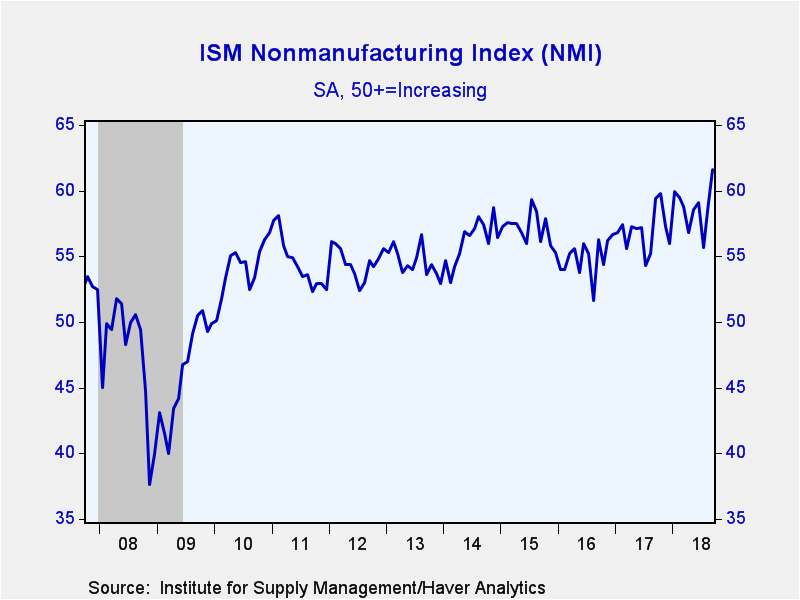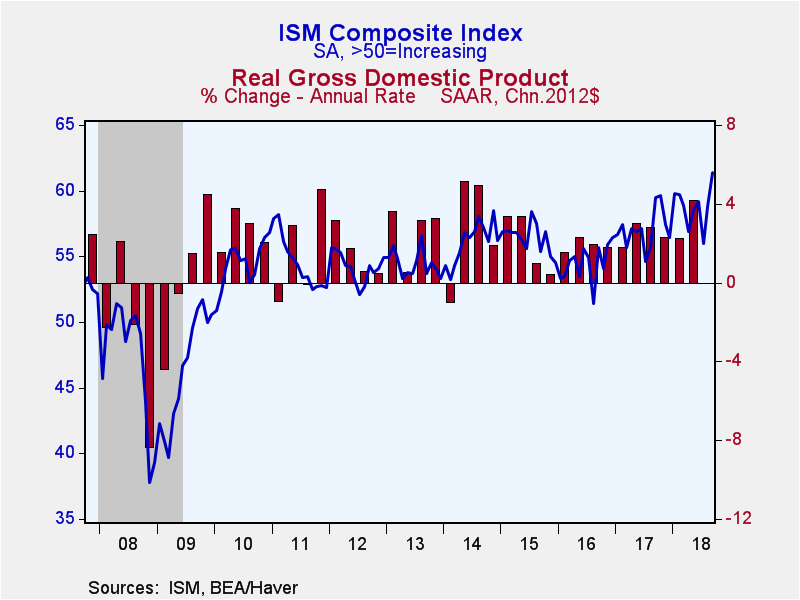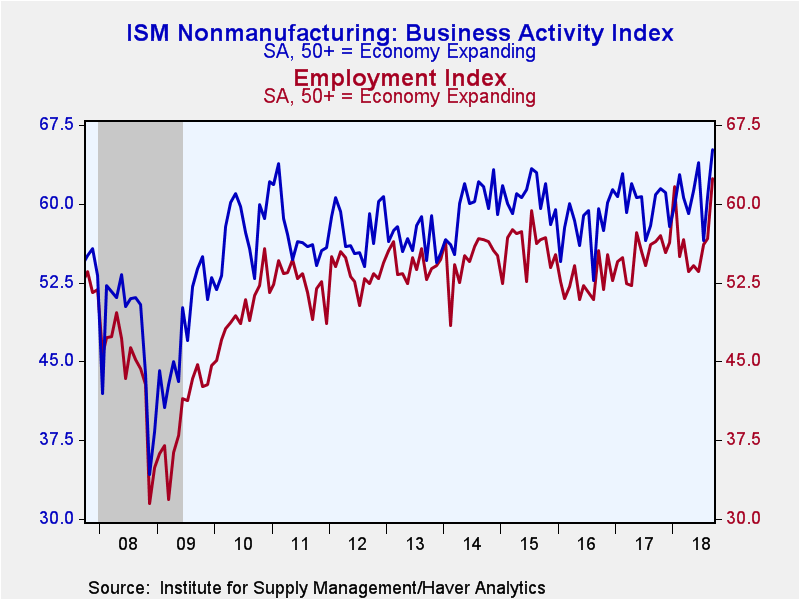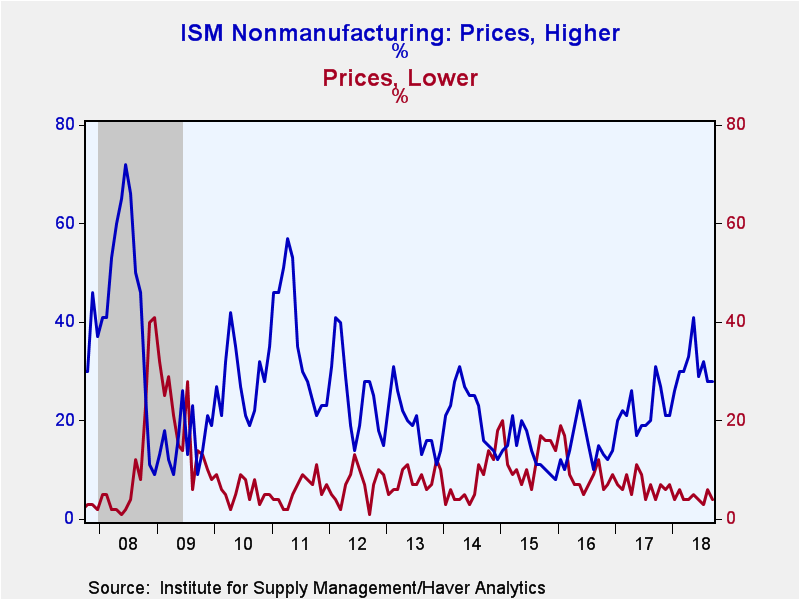 Global| Oct 03 2018
Global| Oct 03 2018U.S. ISM Nonmanufacturing Index Jumped Up in September
by:Sandy Batten
|in:Economy in Brief
Summary
The Composite Index of Nonmanufacturing Sector Activity from the Institute for Supply Management (ISM) jumped up to 61.6 in September from 58.5 during August. This is the second highest reading in the history of the series dating back [...]
The Composite Index of Nonmanufacturing Sector Activity from the Institute for Supply Management (ISM) jumped up to 61.6 in September from 58.5 during August. This is the second highest reading in the history of the series dating back to July 1997, exceeded only by a reading of 62.0 in August 1997 and clearly indicates that the US nonmanufacturing sector continues to motor along. The Action Economics Forecast Survey expected a reading of 58.0. The ISM measures are diffusion indexes where readings above 50 indicate expansion.
Haver Analytics constructs a Composite Index using the nonmanufacturing ISM index and the ISM manufacturing measure, which was released on October 1. This composite rose to 61.4 in September from 58.8 in August, the highest reading in the history of the series. During the past 15 years, there has been a 71% correlation between this index and the quarter-on-quarter change in real GDP.
Each component series in the nonmanufacturing survey increased. The business activity reading jumped to 65.2 in September from 60.7 in August, the second highest reading in the history of this series (the highest being in January 2004). In the breakdown of the respondents into 18 industries, no industry reported a decline in activity in September from August with only one reporting no change. New orders rose more modestly to 61.6 from 60.4. The employment index soared to 62.4 from 56.7, its highest reading ever. And the supplier deliveries index edged up to 57.0 from 56.0.
The prices paid index eased to 64.2 from 62.8, and continues on a modest upward trend since the beginning of 2018. Twenty-eight percent of firms (NSA) faced higher prices while only four percent of firms paid less in September. Prices paid were unchanged for the rest.
Among the other detail indexes, which are not seasonally adjusted, the export order series strengthened m/m, but has been broadly stable this year. The import index jumped up to its highest reading since January, while the order backlog index rebounded further after the sharp July decline.
The ISM figures are available in Haver’s USECON database, with additional detail in the SURVEYS database. The expectations figure from Action Economics is in the AS1REPNA database.
| ISM Nonmanufacturing Survey (SA) | Sep | Aug | Jul | Sep'17 | 2017 | 2016 | 2015 |
|---|---|---|---|---|---|---|---|
| Composite Diffusion Index | 61.6 | 58.5 | 55.7 | 59.4 | 57.0 | 54.9 | 57.1 |
| Business Activity | 65.2 | 60.7 | 56.5 | 60.9 | 60.1 | 58.0 | 60.8 |
| New Orders | 61.6 | 60.4 | 57.0 | 62.2 | 59.3 | 57.5 | 59.2 |
| Employment | 62.4 | 56.7 | 56.1 | 56.4 | 55.2 | 52.6 | 56.0 |
| Supplier Deliveries (NSA) | 57.0 | 56.0 | 53.0 | 58.0 | 53.2 | 51.5 | 52.5 |
| Prices Index | 64.2 | 62.8 | 63.4 | 65.9 | 57.7 | 52.6 | 50.6 |
Sandy Batten
AuthorMore in Author Profile »Sandy Batten has more than 30 years of experience analyzing industrial economies and financial markets and a wide range of experience across the financial services sector, government, and academia. Before joining Haver Analytics, Sandy was a Vice President and Senior Economist at Citibank; Senior Credit Market Analyst at CDC Investment Management, Managing Director at Bear Stearns, and Executive Director at JPMorgan. In 2008, Sandy was named the most accurate US forecaster by the National Association for Business Economics. He is a member of the New York Forecasters Club, NABE, and the American Economic Association. Prior to his time in the financial services sector, Sandy was a Research Officer at the Federal Reserve Bank of St. Louis, Senior Staff Economist on the President’s Council of Economic Advisors, Deputy Assistant Secretary for Economic Policy at the US Treasury, and Economist at the International Monetary Fund. Sandy has taught economics at St. Louis University, Denison University, and Muskingun College. He has published numerous peer-reviewed articles in a wide range of academic publications. He has a B.A. in economics from the University of Richmond and a M.A. and Ph.D. in economics from The Ohio State University.










